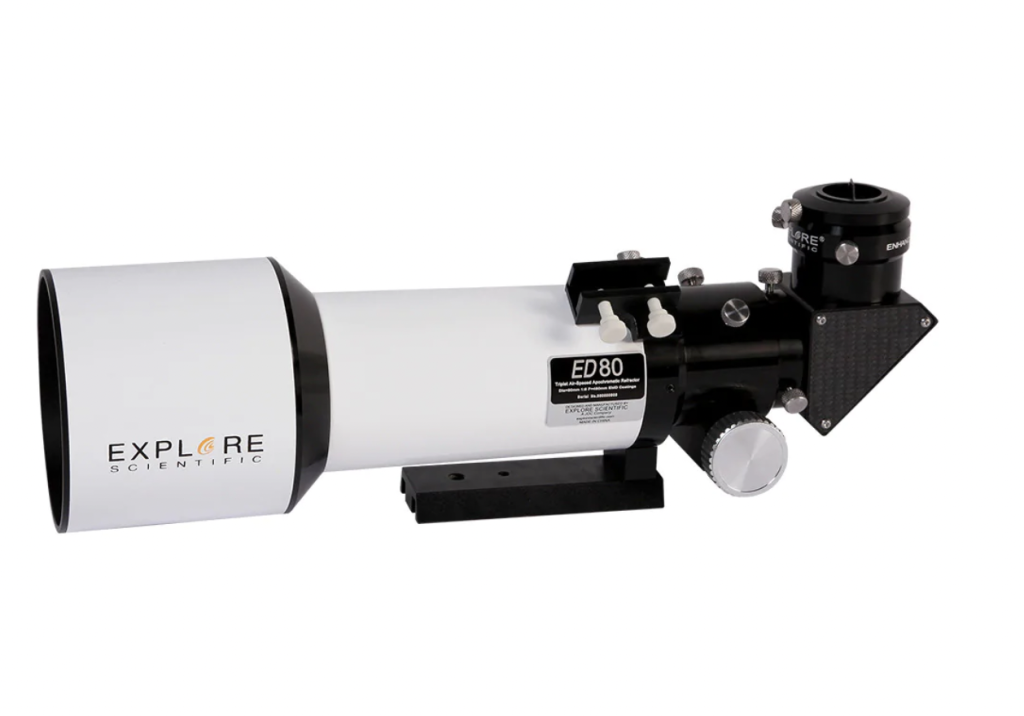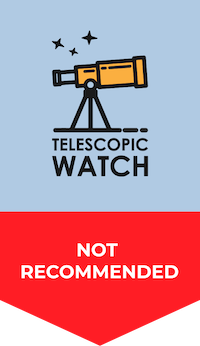The ED80 Essentials Triplet is an 80mm (3.2”) f/6 triplet apochromatic refractor with a focal length of 480mm. The ED80 Essentials Triplet has quite a bit of chromatic aberration for a triplet refractor, mainly manifesting itself as blue halos around the Moon, planets, and some bright stars. This alone is a bit of a disappointment, as many are led to believe that triplets by default simply lack chromatic aberration entirely. Some people seem to be unaware of this issue; oftentimes it can be confused for aberrations in the eyepieces you’re using, and older observers with yellowed corneas may not be able to see the modest blue halos around bright objects at all. For the price, it’s acceptable. If you want perfection, Astro-Physics, Stellarvue, and Takahashi are going to happily quintuple the price you pay.

The optical quality of the ED80 Essentials-and indeed, all of the Essentials triplets, it seems-also tends to be variable; some units can have significantly more chromatic aberration or simply not-sharp stars entirely. Explore Scientific’s customer service is great, and they’ll usually work with you to address any issues, but dealing with a defective scope can still be a hassle.
The ED80 Essentials also suffers from quite a bit of field curvature – both visually and photographically. For visual astronomy there’s little you can do besides try to ignore it; for astrophotography, you absolutely need a field flattener to take good images. Explore Scientific sells their own flattener, but almost any field flattener or reducer-flattener combination will work with the ED80 Essentials Triplet.
The biggest flaw in the ED80 Essentials Triplet-at least for imaging-is neither the field curvature nor residual chromatic aberration inherent in its optics. The largest problem is that the lens cell’s collimation screws poke into the light path, introducing diffraction spikes on stars similar to what is seen in a Newtonian reflector. Other telescopes have this issue occur from time to time, but the problem is usually remedied by backing off the collimation screws. In the case of the ED80 Essentials, this isn’t enough in some units, and so the only solution is to make a ring of some sort to put in front of the objective lens and stop the aperture down by a few millimeters to keep the screws out of the light path of the telescope. This slows the scope for photography and dims the image visually—far from ideal.
Mechanics
The ED80 Essentials Triplet features a sliding dew shield that can be retracted for transporting the telescope. It reduces the length of the tube by a few inches, which is helpful if you are trying to fit the scope into a case or bag. However, the dew shield on newer and current units is ridiculously oversized and doesn’t do a particularly good job of keeping dew or stray light off of the objective lens, in addition to looking ridiculous.
For a focuser, the ED80 Essentials is provided with a dual-speed 2” Crayford focuser with a brass compression ring. The whole focuser can be rotated by loosening a thumb screw. This focuser works well, but it can slip under heavy loads, and the rotating design means it can sometimes become out-of-square with the optical axis of the telescope. It’s not exactly the best.
As previously noted, the scope’s objective lens can be collimated to compensate for issues with tilt in the focuser, but this introduces an additional hassle, and collimating refractors is something that really isn’t easy to do if you haven’t dealt with a lot of telescopes of different optical types before.
To attach a finder or guide scope, the ED80 Essentials Triplet now features a hybrid finder bracket that can accept GSO/Synta-style finder brackets or Explore Scientific/Meade-style brackets. Older units can only accept the latter, which can be annoying as pretty much no guide scopes are offered with the ES/Meade bracket style by default.
Unlike most quality instruments, which come with tube rings to allow for rotating or sliding the optical tube once attached to a mount, the ED80 Essentials Triplet just has a dovetail bolted directly to the bottom of the tube. This is done to allow the dew shield to retract. If you want to attach a guide scope to the top of the tube, you’ll need rings. If you care about maximum stiffness, you’ll need rings. So ultimately, there is really no way to avoid buying rings, but Explore Scientific has chosen to offload this process and expense to the customer. The rings also need screws and dovetails to match, and will prevent the gigantic dew shield on the ED80 Essentials from retracting.
Accessories with ED80 Essentials
The only actual accessory included with the ED80 Essentials Triplet is Explore Scientific’s carbon-fiber 2” star diagonal, which has dielectric coatings. It’s a pretty good diagonal, but as with the main optics of this telescope, there are occasional quality control variations that make them unusable. Explore Scientific is usually pretty helpful if you get a lemon, thankfully. If you’re buying this scope for astrophotography, you can ignore the diagonal entirely and trade it for an imaging accessory if you feel so inclined.
A set of spacer rings to install ahead of the focuser are also provided with the Explore Scientific ED Triplet telescopes to achieve focus with different eyepiece or camera configurations.
Mount Recommendations
The ED80 Essentials Triplet is heavier than it looks thanks to its bulky design and triplet objective lens, and consequently, this telescope needs a pretty substantial mount and tripod to carry it well. Something with over 10 lbs of capacity is needed for visual or imaging use.
For visual use, something like a Sky-Watcher AZ-GTi or an Explore Scientific Twilight I is sufficient for the ED80 Essentials Triplet. A medium-duty equatorial mount such as a CG-4 or Exos-2 will also work for visual astronomy. For astrophotography, plan on purchasing an HEQ5 or Advanced VX-sized mount. A glorified star tracker is not going to be able to hold this telescope acceptably for any period of time.
Should I buy a used Explore Scientific ED80 Essentials Triplet?
Given the issues with these scopes that led to our hesitance to recommend them, we wouldn’t recommend the ED80 Essentials Triplet used unless you get it at a good price and are okay with stopping down the telescope. If you can obtain a used unit-preferably one with the older, slimmer dew shield if possible-for less than the cost of a good 72-80mm doublet (~£320), it’s not going to be any worse than one of those, and if you’re lucky, the performance might be quite a bit better than a cheap ED doublet.
Alternative Recommendations
There are a few different alternatives to the ED80 Essentials we’d recommend at a similar price tag, depending on your preferences. All of these scopes are meant for imaging. You can spend more on a fancy high-end triplet if you wish, but here are our picks for low-cost ED doublets which will serve a similar role and aren’t too demanding on mounts or your wallet.
- The William Optics ZenithStar 81 may be a doublet, but it’s lighter, stiffer, and more well-made than the ED80 Essentials Triplet at a similar price tag.
- The Sky-Watcher Evolux 82ED is similar to the ZenithStar 81 but comes with a slightly beefier focuser and tube clamp.
- The William Optics ZenithStar 73 offers significantly improved mechanics and better quality control compared to the ED80 Essentials, with a lighter weight and only slightly less aperture.
- The Apertura 72mm FPL-53 and Sky-Watcher Evostar 72ED are similar to the ZenithStar 73 optically, and a little cheaper too.
Astrophotography Capabilities
What you can image with the ED80 Essentials Triplet is strongly dependent on your mount, camera, guiding setup, and light pollution conditions. A typical 0.8x reducer brings this scope down to an 80mm f/4.8 with a focal length of 385mm, which is quite short and gives you a very wide field of view. At its native focal length of 480mm, the ED80 Essentials Triplet is still very much a wide-field telescope primarily meant for large nebulae and star clusters, but you can shoot galaxies with it too-just don’t expect a fantastic image scale. The ED80 and scopes of its size and focal length are great for imagers just starting out with EQ5-class mounts and will work acceptably with one even in the absence of autoguiding. For galaxies, you really need something with more aperture, a focal length of 700mm or longer, and also a big and beefy mount capable of supporting such a telescope for long exposures with little in the way of tracking errors. That is all outside the ED80 Essentials-or indeed any 80mm refractor’s-domain.
The ED80 Essentials’ small aperture and refracting optics make it a poor choice for Solar System astrophotography. A large Schmidt-Cassegrain, Maksutov-Cassegrain, or Newtonian reflector with 6” or more of aperture and preferably a long focal length (or a strong Barlow to get the system to f/20 or above) is a much better choice.
What can you see?
The ED80 Essentials Triplet is really an astrophotography telescope, but that doesn’t mean you can’t look through it. It’ll show you the phases of Venus; Mercury might be a little difficult. You can see the polar ice cap on Mars and maybe one or two dark spots under ideal viewing conditions, and the Moon looks lovely as it does with any telescope, showing you thousands and thousands of interesting features on its surface on almost any night. Jupiter’s cloud belts, the Great Red Spot, and its moons can be seen, though resolving the moons and their shadows clearly into disks usually requires a bigger telescope with better optics than the ED80 Essentials Triplet. Saturn’s rings look lovely, and you might be able to resolve the Cassini Division in them and a few cloud belts on the planet, along with a few moons. Uranus and Neptune will look like fuzzy bluish-green dots, difficult to distinguish from surrounding stars even to the discerning eye.
Despite its small aperture, the ED80 really shines visually on deep-sky objects—provided you don’t have too much light pollution to wash out their feeble brightness. Even the largest open star clusters, such as the Pleiades or the Sagittarius Star Cloud, look magnificent. With a good UHC nebula filter and dark skies, you can view large nebulae like the Veil, the North America Nebula, and more. Unfortunately, the ED80 Essentials Triplet lacks sufficient aperture to show much with regards to galaxies, globular clusters, or planetary nebulae.

